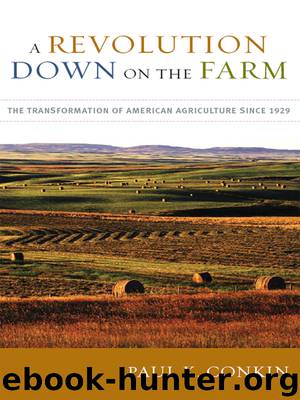A Revolution Down on the Farm by Paul K. Conkin

Author:Paul K. Conkin
Language: eng
Format: epub
Publisher: The University Press of Kentucky
Figure 10. Old Red, a 1943 International Harvester cotton picker, one of the first successful models. (National Museum of American History, a gift of Producers Cotton Oil Company)
Cotton pickers experienced the same shift in size and power as did combines. Self-propelled from the beginning, the machines grew in size with each decade. Today, some machines can pick six or eight rows, and a few, adapted for close-row planting, can harvest twelve. The cabs of pickers resemble those of combines, and GPS technology is beginning to allow the same type of field mapping. Complementing the picker is a new technique of getting the cotton to gins. More than 90 percent of cotton is now emptied from the bins of pickers into long, trucklike containers called modules, in which special tamping devices compact the cotton into tight, weather-resistant, truck-size bales that can be left in the field for days before tractor trailers haul them to the gin.
Structurally, the picker helped concentrate the Cotton Belt in the more expansive farms of the Mississippi Delta, the plains of central Texas, and the irrigated fields of the San Joaquin Valley of California. It was never useful on small cotton farms and in small fields. Thus small farmers either stopped growing cotton or sold out to larger farmers. In the Piedmont, few cotton farms survived except in parts of Georgia. In the 1930s around a million farmers grew cotton. By 1950, just as mechanical pickers began to have a wide impact, the number of cotton farms was down to just over 300,000. By 1974, when almost all cotton was picked by machine, the number was 80,000. In 2002 the number of cotton farms had shrunk to fewer than 25,000, with only 11,000 large farms producing 85 percent of the total. In much of the South, soybeans have all but replaced cotton, which has faced intense foreign competition and suffered from the use of synthetic fibers.7
Gradually, the mechanized cotton industry eroded the old sharecropping system of the South, even as it drove small farmers out of business. New Deal farm policies and wartime labor scarcities in the North had already lured more than 3 million migrants from the South to the North between 1930 and 1950, before the cotton picker had much impact. Approximately 2 million of these migrants were black, and almost all were from rural areas. From 1950 to 1970, in the midst of the technological revolution in cotton, more than 4 million southerners migrated, half of them black. This was the greatest internal migration in American history. These migrants in the 1950–1970 period often left not because they were pushed out by farm owners but because of the pull of northern jobs and, for blacks, greater equality. The push and pull were always interactive, but the end result was a transformed and much more efficient southern agriculture and a rapid reduction of farm labor in the South, with almost all blacks leaving agriculture (only 30,000 black farm operators today). Even among historians, the images associated with this migration vary immensely.
Download
This site does not store any files on its server. We only index and link to content provided by other sites. Please contact the content providers to delete copyright contents if any and email us, we'll remove relevant links or contents immediately.
The Lonely City by Olivia Laing(4714)
Animal Frequency by Melissa Alvarez(4370)
All Creatures Great and Small by James Herriot(4197)
Walking by Henry David Thoreau(3864)
Exit West by Mohsin Hamid(3748)
Origin Story: A Big History of Everything by David Christian(3595)
COSMOS by Carl Sagan(3519)
How to Read Water: Clues and Patterns from Puddles to the Sea (Natural Navigation) by Tristan Gooley(3376)
Hedgerow by John Wright(3244)
How to Read Nature by Tristan Gooley(3217)
The Inner Life of Animals by Peter Wohlleben(3205)
How to Do Nothing by Jenny Odell(3204)
Project Animal Farm: An Accidental Journey into the Secret World of Farming and the Truth About Our Food by Sonia Faruqi(3145)
Origin Story by David Christian(3121)
Water by Ian Miller(3093)
A Forest Journey by John Perlin(3012)
The Plant Messiah by Carlos Magdalena(2843)
A Wilder Time by William E. Glassley(2795)
Forests: A Very Short Introduction by Jaboury Ghazoul(2768)
